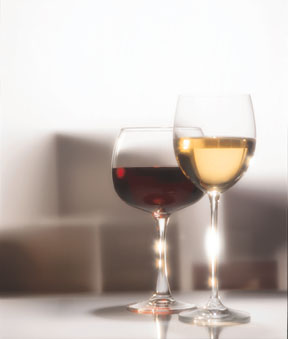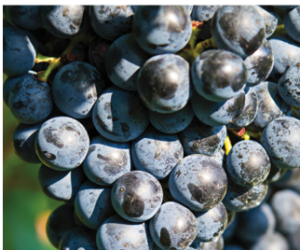Sangiovese is primarily associated with wines from Italy, especially from the Tuscany region. However, there are also a number of vineyards in the New World growing Sangiovese. The 2012 California Grape Crush Report shows winemakers in the state crushed 9,400 tons of Sangiovese. Here are two pros who contributed to that number.
Steven Kirby is the Director of Winemaking at BARRA of Mendocino and Girasole Vineyards in Redwood Valley, California. Steven has a degree in viticulture and enology from UC-Davis and a master’s of business administration from Sonoma State University.
Sangiovese is generally more fruit-driven and less tannic than many of the other best-known Italian varietals such as the Nebbiolo-based wines of Piedmont. On its own, Sangiovese does not typically make a dark colored wine, but the wines are darker and more tannic than Pinot Nero. This is one of the reasons we will blend small quantities (5% to 10%) of other varietals with our Sangiovese to achieve a more balanced wine. Cabernet Sauvignon, Merlot and Petite Sirah are all possible varietals for blending. They contribute both color and darker fruit characteristics, but should be used sparingly to avoid diluting the varietal character.
Charlie Barra (who owns BARRA of Mendocino and Girasole Vineyards, and has been growing grapes in northern California for over 60 years) says if he were marooned on an island and could only have one type of wine to drink, it would be Sangiovese! In my mind, that’s an excellent selection.
Good Sangiovese is extremely versatile and pairs well with a variety of foods. While it might sound a bit cliché, any dish with a tomato base is an ideal candidate for this wine. It can also
stand alongside a variety of meats, including roast lamb, steak, or even chicken. One of my favorites is pasta with a lamb sauce, but a quattro formaggi pizza with a red sauce will do the trick too. It is one of the most versatile red wines from this perspective. It can have many personalities, but is never too extreme to be versatile.
Some people say that Sangiovese is a difficult grape to grow outside of Tuscany, but if California were the origin of wine production, people would likely say that such and such varietal is difficult to grow outside of California. Coastal California has multiple climates, and one can find a perfect climate for nearly anything in the coastal regions of the Sunshine State.
The climate in Redwood Valley is ideal for growing a New World version of the wines of Tuscany. Warm days and cool nights are typical during the summers. The varietal needs the warm days to ripen, but with the cool nights, the grapes keep their acidity, thereby achieving a balance similar to the wines of Chianti. That acidity is a key component of the wine’s ability to pair so well with so many different types of cuisine.
Our Sangiovese vines are spur pruned and cordon trained, one of the common practices in our vineyards. We space them 8-feet (2.4-m) by 12-feet (3.7-m), which is a traditional California vine spacing and a common spacing in our vineyards. This wider spacing leads to fewer vines per acre compared to the tighter spacing currently in vogue in the newer vineyards of California. We have 1,775 vines on 3.25 acres of Sangiovese. From that, we are looking at 3 to 4 tons per acre, so a total of about 9 to 13 tons each harvest.
If you are making Sangiovese wine at home, I would mention that while Sangiovese ages nicely in barrels, you should avoid using new oak that can impart more flavor than desired. Also, depending on the region where you are growing Sangiovese, it is important to have enough hang time to allow the acid to soften in order to create a balanced wine. I don’t recommend extended skin contact for Sangiovese because it is important to preserve the fruit aromas and medium to light tannin structure that are hallmarks of the varietal.
Matt Reid is a UC-Davis trained winemaker who produces Sangiovese and other wines for Benessere Vineyards in St. Helena, California. He consults for Burgess Cellars and makes wine under his own label, The People’s Wine Revolution. Matt’s wine career began when he found Judith Irwin’s Homemade Wine on a bookstore’s remainder shelf. He continues to make wine at home with the help of his daughter.
Sangiovese is the quintessential Italian variety, grown in most parts of the country. Known by its signature flavors of cherry and leather, we produce a varietal Sangiovese and also feature it in blended wines, including our flagship “Phenomenon,” a blend of Cabernet Sauvignon, Sangiovese and Syrah.
Our estate vineyard is on the Napa Valley floor mid-way between St. Helena and Calistoga. This is near the narrowest part of Napa Valley, where it can get quite hot. Our Sangiovese is planted in a loose, silty loam near the Napa River. The vines respond well to the heat and sun exposure and are largely sheltered from wind.
Our trellising system for Sangiovese is vertical shoot position. This works well for us and opens up the fruit zone so we can manage the crop load. We farm all of our blocks individually, responding to the particular needs of the vines in each block. However, we have no special protocols for Sangiovese. We just keep an eye on everything. Sangiovese will set a heavy crop if it is allowed. In our relatively fertile site with ample water, a somewhat heavy crop is acceptable (4 to 4.5 tons per acre). As with any variety, it all depends on the site. Sangiovese clusters are large so the relatively high crop load can be achieved without stacking clusters.
Sangiovese is a big, flavorful grape, but don’t be fooled — it is a delicate one. Treat it more like Pinot Noir than Cabernet and you will have great results. Err on the side of gentleness. As with any wine, you should taste it as often as possible to achieve the desired level of extraction. Oak can easily overwhelm Sangiovese. If you are using oak in your home winemaking, especially alternatives such as chips or cubes, taste daily to avoid over-oaking the wine.







